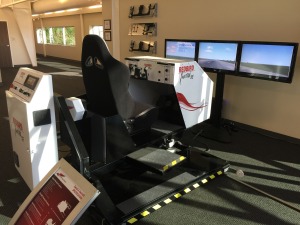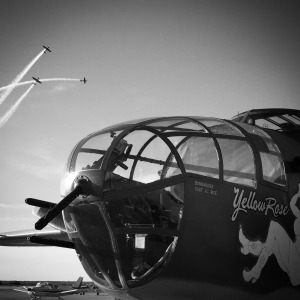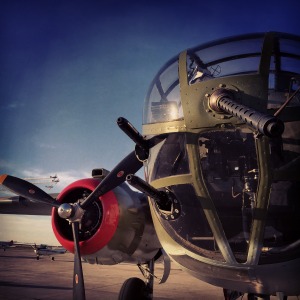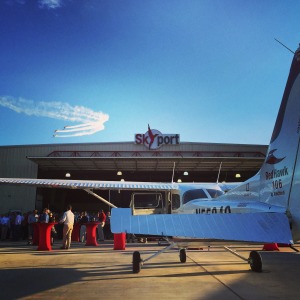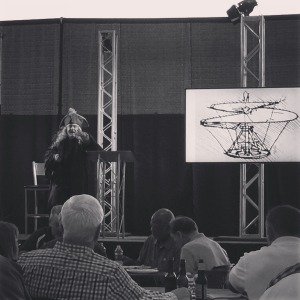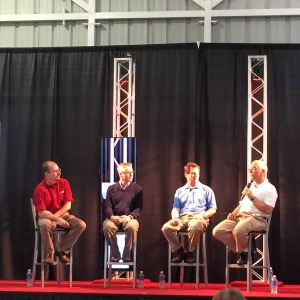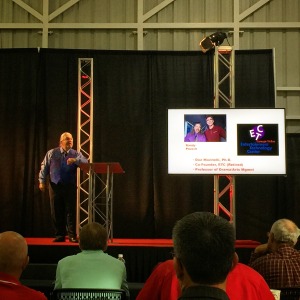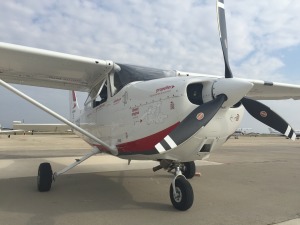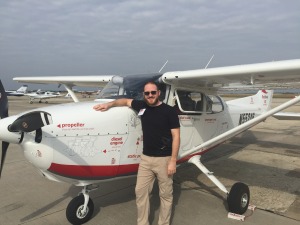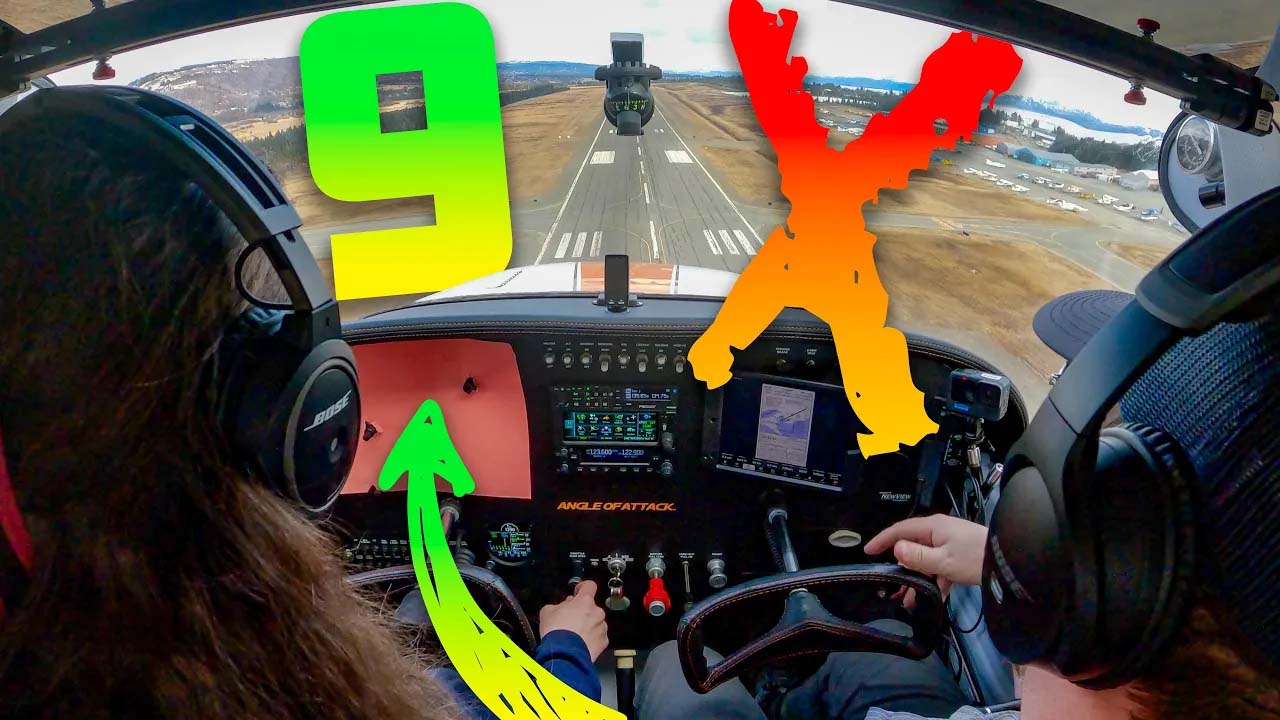AviatorCast Episode 42: Redbird Migration: Connected Airplane | FMX | Redhawk

Today’s Flight Plan
This past week I had the opportunity of attending the Redbird Migration in San Marcos, Texas. This gathering of innovative aviation educators and thinkers is a great place to find out what is new and upcoming in the industry.
My main purpose for going to the Redbird Migration was to get inspired about the future of training, and put new energy into my work at Angle of Attack. I think I was able to eventually do just that.
Many exciting new things happened at this conference. First, we saw the connected airplane. A 172 pulled up to the hangar door of the conference, and as soon as it shutdown, offloaded a bunch of data about the flight. This kind of ‘connected airplane’ has a tremendous amount of possibilities to not only improve flight school processes, but also to analyze quality of flying.
Throughout my time there I also flew many of the different Redbird Simulators, including the FMX, MSX, and the Crosswind Trainer. Lots of great simulators around, and many likeminded people that believe simulation is a great way to train.
All-in-all, the time there was successful. We will perhaps have some great interviews that come from my contacts there.
Useful Links
Redbird Flight Simulations
Electric Airplane
Redhawk
Crosswind Trainer
Commemorative Air Force Central Texas
Music
Big thanks to Atrasolis for providing the great music for our podcast. Please check them out on their Facebook Page or SoundCloud and get the music you’ve heard for free.
Crew
Major thanks to the amazing Angle of Attack Crew for all their hard work over the years. Our team works incredibly hard, and they’re very passionate about what they do.
Now What?
iTunes Subscribe
Want to get regular updates through iTunes? This is the easiest way to automatically download your podcast, and take it on the go. Make sure to SUBSCRIBE HERE.
Email Signup
Want us to let you know via email when episodes of AviatorCast are released? We can do that, too. SIGNUP ABOVE.
Get Started Today!
Want to get started with some of our video training? Go to our main page and signup for Aviator90 (our basic and free course) or other pay products we have.
Transcript
[transcript]
This is AviatorCast episode 42! Mwahahahaha!
Calling all aviators, pilots and aviation lovers, welcome to AviatorCast, where we close the gap between real aviation and flight simulation. Climb aboard, buckle up and prepare for takeoff! Here’s your host, Chris Palmer.
Chris: Welcome, welcome, welcome aviators, you’ve landed at AviatorCast. My name is Chris Palmer. I believe in high quality, personable and modern flight training. I’m a pilot but also a flight educator. I’m the founder and owner of Angle of Attack, a flight simulation training company which is bringing you this podcast today. AviatorCast is weekly podcast where we talk about the spirit of the aviator. We believe flying is an art form, one that we have to continually practice and master. This mastery is gained through a focus on continual learning, human factors, humility, and a commitment to excellence. Show notes, transcript, community discussion and links for this episode can be found by simply going to AviatorCast.com.
So welcome to this, the 42nd episode of AviatorCast. It just so happens that this episode lands on Halloween so that’s why you heard the Dracula intro there. It is my pleasure to have you here and I hope you are all having a great and fun holiday out there trick or treating with your young ones or having some fun with friends. So when you get it sometime here this weekend, probably not today because you will be busy doing other things, go ahead and enjoy this episode of AviatorCast. There are some cool stuff that you guys can grab from this.
So before we get into this episode, I have a review from iTunes. It is from Jawajoe. He says “An epic podcast, five stars. Chris is an amazing host and his podcast is a great mix of aviation and flight sim. I want to thank you Chris for inspiring me to begin my private pilot and can’t thank you enough for the great content. Professionally done podcasts with great flow and phenomenal content.”
So thank you so much Jawajoe, I really appreciate that. I’m excited that you’ve decided to get your private pilot license. That is a big step and a big decision but I absolutely know that you will not regret it so congratulations on that.
Okay, so on today’s podcast, we are going to talk about Redbird Migration. I’ll talk to you about who Redbird is, what the Redbird Migration is, what I saw there, what I learned there, and some takeaways from the migration. So let’s get right into the Redbird Migration.
And now, the flight training segment…
Chris: Alright, so the past couple weeks has been a big whirlwind for me. I’ve been visiting a lot of places and kind of ended up in Texas where Redbird Migration was but before that, I was in North Dakota, Minneapolis, Atlanta, and then down to Texas where I went to the Redbird Migration. I’m going to tell you more about that and what I learned there but along the way in this entire journey over the last few weeks, I learned a whole lot about the future of aviation and how I would like to be involved in on that and I hope I can give you some tips and some information about that as well so you can kind of know about some things that are going on.
So as we’re going to talk about Redbird Migration, I wanted to first talk about who Redbird is just in case you don’t know. So Redbird is a flight simulation company and what they do is they have basically started out, they started out making these really high quality simulators that general aviation flight schools could use. So, kind of the cool thing that they’ve done is they’ve kind of gone I guess the airline style way which is make a full motion really high quality simulator but these are also very affordable so someone like your local flight school can afford one and you can get high quality simulator training. These guys really believe at their core that flying should be more accessible, that a pilot to should be able to get their training cheaper, faster, more effectively, with better curriculum, and everything that they do as a business kind of speaks to this, speaks to getting more pilots in the cockpit, getting more people in the air and simulation is obviously a huge part of that with Redbird.
Now, the flight simulators they do, that’s not the only they do, they have a lot of other initiatives that are kind of going on and I’ll tell you a little bit about a couple of those. But Redbird is a really high quality organization. They’re forward-thinking and they have really grown quite a bit ever since they really started about seven years ago. They’ve really grown into this business that is at the forefront of the future of flight simulation.
So as such, every year Redbird holds the Redbird Migration at their FBO in San Marcos, Texas, and they actually don’t call it their FBO, they call it Skyport. It’s this really nice facility where they have many of their simulators in one section, and then they have a big hangar where we met as kind of conference, and then they have the FBO side and the training side. Kind of just this big, nice facility to push forward their vision of more accessible training. So these guys have done some really kind of forward-thinking things in their short history and a lot of that is breathed and started and talked about and shared and molded at this Redbird Migration. So Redbird Migration is many people from around the world that come together and talk about the future of flight simulation as it pertains to flight training and making flying more accessible for pilots. So it is a lot of people that get together, they’re very forward-thinking and what the mission is is to try to make flying more accessible. At least that’s kind of what I’ve gathered from it.
You have flight schools that come to this, you have aircraft manufacturers that come to this, you have people from AOPA, the FAA, from the EAA. Many, many people from many different organizations, some big players come in together and saying “Okay, how can we do better? How can we make training more accessible?” So that’s in a nutshell what Redbird Migration is. It’s kind of this open thing where if you are that type of person that is forward-thinking and you want to be a part of it, you’re invited to come and it’s a great experience because of that.
So I wanted to share with you a few of the things that happened at Redbird Migration and a few of the things that I learned just so you are kind of aware of them. I think they’re really interesting. Some interesting things kind of going on and these things have been progressing over the years. All of these aren’t new but I think it’s good that you are aware of some of them even if they are a little dated, but some of them are very new, so let’s kind of get into that.
Okay, so one of the big first things that happened at Redbird was we have kind of spent the morning, we had breakfast and there were a couple of speakers and a couple of presentations, and then Redbird presented what they call the connected airplane. So they open up the hangar door, one of their 173s, one of their Redhawks, pulled up to the hangar door and basically turned off its engine and we are watching the screen, just kind of a terminal computer screen on the big screens there on the stage, and the airplane started to offload data. So offloading flight parameters, what had happened during the flight, many, many different things from the aircraft that showed information from that flight, so this is what Redbird calls the connected airplane and I think it’s actually a very interesting thing that could bring a lot of new technology and a lot of depth to flight training.
So all of the data from that flight that an instructor and a student had theoretically just gone through is now offloaded to the system there at the FBO or the flight school. So this can be many things. It can tell you if they flew out of parameters at all. It can tell you how well your own student did, say you were the instructor, how well your own student did. It can start to offload the time that you spent flying in the air which can then go to things like billing and maintenance and all sorts of different things. So as you can see, this can do a lot for your flight school, having these airplanes that can come in and automate a lot of the processes. So kind of the sky is the limit there as far as how creative you would get with a connected aircraft like this but it’s definitely something that’s a compelling thought.
Okay, so now I’m going to talk about the crosswind simulator. I’m going to kind of jump around here. The connected airplane was something that Redbird kind of announced at this migration, the crosswind simulator is not really anything new for Redbird but it was first time that I was able to fly this crosswind simulator, and it’s pretty neat because it’s this simulator that slides along horizontally on these rails and you dial up the wind and the gust and then you have to control the airplane as far as getting it on centerline and then kicking your rudders and doing all that sort of stuff, so pretty neat. I definitely screwed up the first few times and crashed, and then the third time, I got quite a high score but it was an interesting, interesting simulator and I can see just how useful it would be for those trying to learn crosswind landings.
And you know, a lot of students take crosswind landings for granted because they may be in an area where winds aren’t so much a problem, but as a pilot, you will eventually face pretty tough crosswinds and you better know how to deal with them in order to not pile up your airplane. It’s definitely different. I remember that in my training, I got a little bit of crosswind action but it wasn’t until I actually started flying out there in the wild that I actually took those things that I had learned and had to perform and had to perform even more than I had before, going into even more intense winds. So it’s something that you definitely need to know and the crosswind simulator was a really neat things to see. So that’s the crosswind simulator.
Alright, so there was this guy that spoke at the Redbird Migration and his name is Don Marinelli. Really cool guy. I actually don’t think he’s a pilot but he really understands today’s youth or rather today’s new flight students. So, the old school way of thinking with flight training is you kind of read manuals, you go in the airplane, you fly but it’s all kind of this textual, multiple choice based process of learning and it just doesn’t really work, and it’s all kind of left brain in an arena that I believe is a very right brain creative thing in flying. I believe that flying is a very right brain creative thing.
So today’s youth are very different and they call these the Millennials or the Pearls, even the Gen-Xers. These people learn completely different. I kind of put myself in this category where I want to learn with high quality video, I want to learn with great presentations. I’m not super great at sitting down to boring manuals and actually getting something of it, my brain kind of turns off. And I don’t think I’m alone in that. I think a lot of you out there are the same exact way.
So, Don Marinelli got up there and talked about why all these is and how we as flight educators need to change the way we’re approaching flight education and flight training and to do it for this type of generation. In thinking that, I really got thinking about how our videos here at Angle of Attack can be better and how we can do better for those trying to learn not just for this generation but I believe that there are many other generations, even the older generation, that enjoys learning through video too. I really took that to heart and I’m really hoping to make improvements on what we already have.
I actually talked to Don Marinelli after the fact and I’m hoping that we’ll have him on the show to talk more about this sometime. We’ll just see what his availability is like, but this is a guy that really does appreciate aviation. In fact, on that night, he got up after dinner and he played Leonardo Da Vinci in this kind of talk and it was really neat how he did that. Leonardo Da Vinci was definitely a guy that thought outside the box and did some things differently and he came up with a lot of these things in aviation that 400 years ago we’re pretty outlandish but now we’re realizing “Wow, this guy was on to something and he was pretty right about a lot of things.” Anyway, that was really cool too and really neat and I’ll make sure I picture that on this post on the website.
So also at the facility there are at the Skyport, I was able to fly a bunch of the different FMX simulators that Redbird has. The FMX simulator is kind of their top-notch full motion simulator and it was really neat because these are simulators where you can change out the panel and full motion, you get all types of cool, different options that you can do. So I saw a Cirrus, I saw G1000, 172. You can set up many, many different types of airplanes. So kind of a neat approach to doing this simulator in that you can interchange it but they’re all really great and I was able to fly some of those so that was kind of fun.
Alright, then there was a presentation on this new electric airplane that’s going to come out and this thing is pretty unbelievable. It has an electric engine. You don’t have any conventional engine parts. This engine weighs 20 pounds, as a result the propeller can be smaller, there’s only one moving part in the engine. It’s really interesting and it could potentially mean a lot more accessible flight training and cheaper flight training. This aircraft is specifically made for flight training. It’s not really a cross-country airplane, just a very light aircraft with room for a couple people in it. But it can stay aloft for three hours and during that time, it can charge with its solar panels on the wings. So the efficiency of the batteries and the solar charging is getting to the point where there is starting to make a lot of sense, and so this company that is doing this is really forward-thinking in the fact that this is an all-electric airplane and it is on the horizon and it could happen very soon. So that’s one of the more, not outlandish but one of the bigger new technologies that came out of this Redbird thing that I saw. Really, really cool.
Okay, I have the opportunity to fly one of the Redbird Redhawks. The Redhawks are older 172s that Redbird totally strips down. All they leave is the frame and then they replace everything. They replace the panel, they replace the seats, they replace all he interior, they replace the engine and a lot of the other components that are there in the airplane, and they essentially come out with a brand new airplane that operates at a much lower cost. So you still get a lot of the glass panel stuff but the biggest difference about this airplane is that it has a diesel engine from Continental, 135-horsepower if I’m not mistaken and it burns 5.5 gallons an hour. No matter what phase of flight you’re in, takeoff, cruise, landing, whatever it is, 5.5 gallons an hour. If you’re not familiar with how much fuel airplanes burn, it’s generally between 10 and 15 and sometimes even more than that per hour. So 5.5 gallons per hour which in probably the worst case is half, that is a very, very low cost for operating and so it’s very compelling.
Along with that, the engine operates a little bit differently. You don’t have the mixture anymore. All you have is one lever and it is controlled by a FADEC which handles all of the mixture and a lot of the operation of the engine automatically. So I have the chance to fly this. It was a lot of fun. We just buzzed around the pattern a couple of times. We had to dodge some eagles in the process but this was a very cool airplane and it was neat that it was running at that efficiency and it just felt new, it was great. All the avionics were great. It had a new, I think a G500 in it, and then it had some of the newer Garmin touch screen GPS in it. Really high quality. Great aircraft.
And then to kind of end my trip there on the last day, I went over to the commemorative air force and that is a place there right in the airfield where they redo and they remake World War II aircraft. They overhaul them, they get them into flying shape and so they can go out and actually fly and they had all sorts of different airplanes there. They had a B-25, they had some Texans, and they had some Japanese airplanes, they even had an old Chinese airplane that is kind of a communist airplane. So a lot of cool and different airplanes there. I really love that generation of flying. It’s just always interesting to me how fast the technology accelerated during that time and it actually went very far ahead of what it was actually capable and flying was very dangerous as a result during the war because these airplanes were just so high-powered and they really didn’t understand everything about them yet. They’re kind of like old muscle cars to me. I just love these old airplanes and so it was cool to go over to that, that big, big hangar and kind of see all of these operations happening.
So those are just a few of the things I saw Redbird. Some of them are very interesting, some of them are just kind of cool from an experience perspective, but I kind of wanted to over what my takeaway was or what kind of things I took away from this Redbird Migration because I did go there after all to be inspired. I didn’t really go there for any other reason except for the fact that I knew these guys were forward-thinking and I wanted to be a part of that.
So one thing I really took away from this Redbird Migration and it’s actually something that Don Marinelli summed up very well in his skit as Leonardo Da Vinci and that is that we right now are the innovators and it is absolutely up to us to innovate and think forward and do these things that Leonardo Da Vinci was trying to do back in the day. It is up to us, and so that is probably thing I took away from Redbird Migration and I feel like each thing that I learned, each step that I want to take, it all comes back to the fact that I am an innovator and it’s up to me and I need to go out and do what I need to do in order to carry flight training forward. So that’s kind of what I took from it.
Another thing I took away from it was that today’s generation will learn differently and this is something I wasn’t necessarily blind to. I’ve always thought all along that video was such a better way to learn than just reading thousands of pages of manuals and I think you younger generation out there, that generation that’s just kind of getting started with your flight training, you feel the same way. You don’t necessarily like to read through thousands of pages of manuals, but you really do enjoy and you pick up on and you want high quality media like video, so I thought that was really cool. Even podcasts kind of go with today’s generation as well.
Another thing I kind of brought out of this and it goes along with innovation but it’s kind of a saying that you hear every now and again and that saying is “Sometimes it’s better to ask for forgiveness than permission.” And what I mean by that is we don’t always have to make sure that everything is safe and that all the regulations are in place for us to go out and innovate. Now, I’m not saying that you go out there and you make a really crappy airplane and you could try to go fly it. What I’m saying is is that if you have an idea about how training can be different and how it can teach pilots better these days, then why not try to do it that way? The end result is obviously you’re still going to make a great aviator, but the way you do it between the beginning and end might be different then what someone has thought of before, and just because everyone is kind of doing it one way and that’s the way we’ve been stuck in for a long time, it doesn’t mean that we can’t do it differently, and so that’s why I say sometimes it’s better to ask for forgiveness than permission. Go out and do it and then figure out how to get it approved. I don’t know. Maybe I’m being too antiauthority by saying something like that but that’s kind of one thing that stood out to me, that you don’t have to get permission from anyone to go out and do something great.
Another big thing at Redbird and this is one thing that a lot of people are there for and that is there is a big effort to improve flight training, and a big effort by many of the flight schools, many of the universities out there to really make a difference, to really change the way they’re training for the better, and so I really thought that was encouraging seeing such a wide variety of different people together in that effort and as a result, that kind of brings me to this last point is, we’ve been on this podcast here for I guess now 42 episodes and we’ve talked a whole lot about bridging the gap between flight simulation and real aviation and how that is so integral in today’s world. Obviously, thinking forward and being innovative has a lot to do with flight simulation right now because it’s cheaper to run a flight simulator than it is to actually fly an airplane.
But one thing I learned from the Redbird Migration is that we aren’t alone in those thoughts and we aren’t alone in this quest. There are so many more people out there that really believe that flight simulation is a fantastic platform in which to learn to fly and that it can really improve pilots, it can help pilots get their licenses faster at a cheaper cost, all sorts of great, great things. Now, we obviously don’t want to do all these things, flight simulation, cheaper cost, faster flight training, at the expense of quality flight training. That’s not really the point. The point is to just do all these more efficiently and again, we are not alone in that quest, so I found that very encouraging.
This experience at Redbird is really great for me. I met a lot of fantastic people. I saw some new and great and innovative things and it just really encouraged me to continue forward in my quest to make a difference in aviation training with what we do here at Angle of Attack with the video and some of the other efforts we are thinking up. I just feel encouraged and energized to continue that process and know that there are others out there in support of that that will enjoy it as well. And I truly believe that we are in many ways ahead of the curve in the sense that a lot of flight schools out there are trying to do the same old thing and we are here innovating and doing different things with flight simulation and with video and a lot of other different aspects of what we do here.
But I digress on that. I just want to thank anyone who’s listening to this that went to Redbird for being there and for participating and being part of that community that is trying to innovate and take forward flight simulation and flight training. I just really appreciate all of those efforts and hope that that can only continue and that it can continue at an accelerated rate. I would really love to see that. I’m really appreciative of all the support that’s out there in the community right now for these efforts. So that’s it. I’m just going to close by saying that.
Alright, so let’s wrap up the show. You can take a quick two-minute survey at survey.aviatorcast.com. Here you can give us ideas for upcoming shows if you want to see certain topics. You can also join in on the conversation for this episode at AviatorCast.com or write me directly at me@aviatorcast.com. I’d love to hear from you in either location and I do answer every email that I get. You can also get every episode of AviatorCast. You can get do that by subscribing through iTunes, Stitcher, YouTube, SoundCloud and more. We have it in a lot of different locations. iTunes is kind of the main one but it’s up to you where you get it. We’d also love to get an honest review from you on iTunes. That is the location that most people learn about our podcast and by you reviewing that, it helps others learn about the podcast so if you did enjoy this episode, we ask you to go there and just leave a simple and short review about what you enjoyed about this show.
If you’d like to check out any of our training products here at Angle of Attack, head to flyaoamedia.com. Start with the basics for free with Aviator90, learn instrument flying and more with AviatorPro or even fly many of the world’s most popular jets virtually with our training products for the 737, 747, 777 and MD-11 again at flyaoamedia.com. Angle of Attack also offers professional video services at AngleofAttackPro.com.
Hope you guys have a wonderful and fantastic Halloween. Thank you for joining us on this episode of AviatorCast.
Many thanks go out to the Angle of Attack crew for all of their hard work for making this episode possible and all they do outside of AviatorCast. These guys are working on things right now that are innovative, forward-thinking and will potentially take us into the future in flight training. And most of all, thank you so much for joining us on this episode of AviatorCast. We are truly grateful to have you here, part of our community and so engaged in this wonderful passion for flying things.
Until next time, throttle on!
[/transcript]
Chief Flight Instructor and President of Angle of Attack. Founded in 2006.

Stay Connected
Be the very first to get notified when we publish new flying videos, free lessons, and special offers on our courses.


